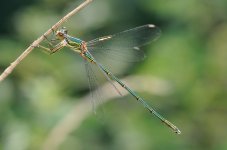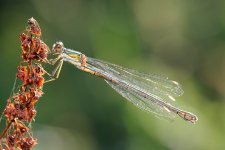-
Welcome to BirdForum, the internet's largest birding community with thousands of members from all over the world. The forums are dedicated to wild birds, birding, binoculars and equipment and all that goes with it.
Please register for an account to take part in the discussions in the forum, post your pictures in the gallery and more.
You are using an out of date browser. It may not display this or other websites correctly.
You should upgrade or use an alternative browser.
You should upgrade or use an alternative browser.
willow emerald Trimley Marshes (1 Viewer)
- Thread starter Steve Babbs
- Start date
More options
Who Replied?Canarybirder
Oenanthe Birding Adventures
1 - 2 males still present this afternoon plus loads of Small Red-eyed Damsels. 10 odonata species at the site.
Cheers
Chris
Cheers
Chris
James Hunter
Well-known member
Take a scope, but at one point this morning one flew past us at head height and away towards the pumping station, so you might get lucky. Best of luck,
James
James
Bismarck Honeyeater
Barely known member
Might be worth popping up to Winterton afterwards as a Southern Emerald Damselfly has been found in the last couple of days.
http://www.dragonflysoc.org.uk/hotnews.asp
GH
http://www.dragonflysoc.org.uk/hotnews.asp
GH
Might be worth popping up to Winterton afterwards as a Southern Emerald Damselfly has been found in the last couple of days.
http://www.dragonflysoc.org.uk/hotnews.asp
GH
Cheers for that info GH...might be a long day tomorrow!
That pool may have dried out tho....will have to think about twitchin Winterton....i'm not doin the driving so we'll have to see! Be happy enuff to see the 'willows'!
All the best....
RoyW
Well-known member
That pool may have dried out tho....
Anyone who does look for the Southern Emerald - or any other Lestes species - needs to be aware that they are often found around ponds that become completely dry during the summer.
The ovipositing females lay their eggs in plants above the dry pond, the eggs then hatch the following spring, after the ponds have filled during the winter, and the larvae develop quickly before the ponds dry out again.
Eventually ponds like this do dry out for good though, so the species that use them need to have the ability to disperse and find new sites (so it's not too surprising that some are reaching Britain).
Roy.
Anyone who does look for the Southern Emerald - or any other Lestes species - needs to be aware that they are often found around ponds that become completely dry during the summer.
The ovipositing females lay their eggs in plants above the dry pond, the eggs then hatch the following spring, after the ponds have filled during the winter, and the larvae develop quickly before the ponds dry out again.
Eventually ponds like this do dry out for good though, so the species that use them need to have the ability to disperse and find new sites (so it's not too surprising that some are reaching Britain).
Roy.
I didn't know that...very interesting Roy...and quite amazing too! We didn't have time to go to Winterton today [to look for southern emerald]...deciding it would be a 'half-hearted' attempt and best to have a whole day searching to maximize any chance of connecting. Had 'point blank' views of two female willow emeralds tho...eye level and below...soon as we arrived on site! Photographers 'filling their boots' as these individuals allowed lenses to be poked to within 2feet..[that is...until an hour later when a couple of buffoons turned up with all the fieldcraft of charging rhino's...then...strangely...the emeralds became a bit more elusive]!
We went on to scarce emerald 'Thompson' site where we spent much time studying these creatures alongside common emeralds...a great day out...
ps...thanx to original finder/s of willow emeralds:t:
Last edited:
Suffolk naturalist
Active member
By a huge coincidence, I found what I think is a new colony of Willow Emerald at another site in East Suffolk today, some distance from the coast. I saw around 20+ individuals. When I got back, I googled the species and came across this thread. I've passed on the information to Adrian Parr and suggest the species is well worth searching for - it may well be resident in Suffolk now.
I haven't had the ID verified, but at the risk of making a fool of myself, will attach a couple of photos, taken today.
Best wishes
Malcolm
I haven't had the ID verified, but at the risk of making a fool of myself, will attach a couple of photos, taken today.
Best wishes
Malcolm
Attachments
Last edited:
StuartReeves
Local rarity
Can someone give a quick summary of the diagnostic features and habitat preferences of Willow Emerald? It's obviously worth keeping an eye out in this part of the world, but it would help if I knew what I was looking for!
Suffolk naturalist
Active member
Thanks to you both, much appreciated. I thought straight away that they didn't look like either scarce or common emerald, having seen both recently. One thing I would add is that, unlike other lestes sp, willow emerald do not favour seasonal pools - at least according to the Field Guide to Dragonflies of Britain and Europe, which states that the species favours almost any standing or slow flowing water surrounded by trees and bushes. So many locations could be suitable and are thus worth checking. The ones I found were on tall grasses and other vegetation in exactly that sort of habitat and were easily approachable late in the afternoon. As the temperature began to drop, some flew up into nearby trees. Certainly a species to look out for...
Suffolk naturalist
Active member
Regarding ID, males lack blue pruinosity and don't have blue eyes. Their appendages are pale. Both male and female have large, pale pterostigmas and a noticeable pointed 'spur' on the border of the green area of the thorax - which you can see clearly in my photos. I would say they are slim - rather like the common emerald, but longer, giving the impression of a bigger insect. They're a large damselfly.
Hope that helps.
Hope that helps.
StuartReeves
Local rarity
Regarding ID, males lack blue pruinosity and don't have blue eyes. Their appendages are pale. Both male and female have large, pale pterostigmas and a noticeable pointed 'spur' on the border of the green area of the thorax - which you can see clearly in my photos. I would say they are slim - rather like the common emerald, but longer, giving the impression of a bigger insect. They're a large damselfly.
Hope that helps.
Thanks, that is helpful.
There is a thread..lower down list..on common and scarce emeralds Stuart...the photo's will tell you all you need to know about the ID.
ps...Malcolm....that male willow emerald is a really good photo...can't stop looking at it...great 'lighting' showing the critter in all it's splendour!
ps...Malcolm....that male willow emerald is a really good photo...can't stop looking at it...great 'lighting' showing the critter in all it's splendour!
RoyW
Well-known member
Malcolm - congratulations on your find, from the sound of it you may have discovered the biggest British colony to date (if we can call them colonies at this stage!).
On identification -
The main potential pitfall is some recently emerged Common Emerald D's. These lack any blue pruinescence, can have a (less prominent) green spur on the side of the thorax, and the pterostigma start off white when first emerged and gradually darken - so they can be pale (see the image in this link).
http://www.wildaboutbritain.co.uk/pictures/showphoto.php?photo=39045
If you are lucky enough to find a male the black tipped white abdomenal appendages, with short lower appendages are diagnostic (Eastern Willow Emerald is extremely unlikely!)
No problems with yours though Malcolm!
On habitat -
One other thing - don't expect them to always be out in the sunshine, on warm days I have more often found this species under trees on the continent, sometimes in deep shade.
Roy.
On identification -
I would agree that if you are familier with Common Emerald Damselfly this species is immediately recognisable as different, appearing large and slim as Malcolm has stated.I thought straight away that they didn't look like either scarce or common emerald, having seen both recently.
The main potential pitfall is some recently emerged Common Emerald D's. These lack any blue pruinescence, can have a (less prominent) green spur on the side of the thorax, and the pterostigma start off white when first emerged and gradually darken - so they can be pale (see the image in this link).
http://www.wildaboutbritain.co.uk/pictures/showphoto.php?photo=39045
If you are lucky enough to find a male the black tipped white abdomenal appendages, with short lower appendages are diagnostic (Eastern Willow Emerald is extremely unlikely!)
No problems with yours though Malcolm!
On habitat -
Like Common Emerald Damselfly, Willow Emerald D is very catholic in it's choice of breeding water. Willow Emeralds lay their eggs in the bark of trees/bushes overhanging the water, so for them it is the surrounding trees that are important (this doesn't mean that they don't use shallow, or dried up ponds, though - they will if the trees are there).One thing I would add is that, unlike other lestes sp, willow emerald do not favour seasonal pools - at least according to the Field Guide to Dragonflies of Britain and Europe, which states that the species favours almost any standing or slow flowing water surrounded by trees and bushes. So many locations could be suitable and are thus worth checking. The ones I found were on tall grasses and other vegetation in exactly that sort of habitat and were easily approachable late in the afternoon. As the temperature began to drop, some flew up into nearby trees. Certainly a species to look out for...
One other thing - don't expect them to always be out in the sunshine, on warm days I have more often found this species under trees on the continent, sometimes in deep shade.
Roy.
RoyW...thanx for posting that link to pic of newly emerged sponsa....very educational! Is the rich colouration on lower/under-sides of thorax and first segments 'typical' of a newly emerged individual? I have not seen 'this' illustrated before...[it should be tho]!....as you say...a definite 'pitfall' to the unwary!
ps...if people are unaware of the appearance of newly emerged sponsa then i'm guessing that there might just be a few 'false alarms'....hopefully not!
ps...if people are unaware of the appearance of newly emerged sponsa then i'm guessing that there might just be a few 'false alarms'....hopefully not!
StuartReeves
Local rarity
There is a thread..lower down list..on common and scarce emeralds Stuart...the photo's will tell you all you need to know about the ID.
ps...Malcolm....that male willow emerald is a really good photo...can't stop looking at it...great 'lighting' showing the critter in all it's splendour!
Thanks, I had seen that thread and I've found Common Emerald pretty close to here, it's just that I wasn't sure whether Willow Emerald was actually in my fieldguide!
Similar threads
- Replies
- 11
- Views
- 825
- Replies
- 0
- Views
- 166
Users who are viewing this thread
Total: 2 (members: 0, guests: 2)






